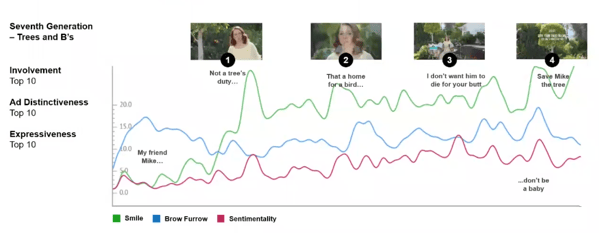Kantar and Affectiva teamed up recently to present How to navigate the emotional world of sustainability in advertising, a webinar focusing on the challenge of sustainability in advertising. The webinar was presented by Vera Sidlova, Jonathan Hall and Ester Boczan from Kantar and Affectiva’s Graham Page.
Using Kantar’s Sustainability Sector Index, Link advertising database, and Affectiva’s Emotion AI, these powerful tools worked in synergy to provide cohesive insights into consumers’ responses to sustainability and a deep dive into top and bottom performing ads that featured social and environmental issues. After conducting a wide study across 35 different countries around the globe, Kantar found that the majority of consumers do indeed care about both social and environmental issues and are ready to make a difference—but they believe that the onus of addressing these issues is on corporations and governments.
This is but one of the main challenges that undermines good intentions. Additional stressors such as inflation and subsequent rise in the cost of living have put environmental concerns on the back burner in some people’s purchasing behaviors. As a result, there is a value-action gap present between the intention towards living more sustainably and people’s actual actions.
Keeping this in mind, brands have the opportunity to make a real difference to the issue and to consumers by supporting and enabling consumers to close this gap and take positive steps towards being more environmentally conscious. And while ads featuring sustainability tripled in 2021, many brands have found it a difficult message to get right, either falling foul of regulators or suffering a consumer backlash against greenwashing. Kantar and Affectiva have done the work to make it easier for advertisers to understand their audiences and to provide guidance on how to get this right.
Viewers’ emotional journey: to guilt or not to guilt?
Ads that tackle issues like poverty, pollution or COVID-19 and healthcare, will often hone in more on the problem rather than the solutions and tangible changes to make sustainability a reality. So which route is the best to take?
Using Emotion AI, we found that top performing sustainability ads generated higher valence, more smiles and joy in audiences, and were from brands who were able to effectively convey a positive and uplifting tone. These ads also evoked feelings of guilt and sadness, but what made them shine was a strong and optimistic call to action with an ending where viewers felt confident, inspired and full of pride. This shows that while guilt can be a powerful tool, there is a fine line between inspiring consumers and leaving them dejected.
Focusing too much on the problem of Sustainability in the creative can lead to increased brow furrow and disgust, indicating annoyance, negativity and rejection. Instead, advertisers may want to consider approaching the issue of sustainability using humor and optimism - strike a balance by taking your viewers on an emotional journey, but help them to see how they can take action, and the role the brand can play in that.
 See the breakdown of participant emotional responses to this ad from the Affectiva and Kantar webinar
See the breakdown of participant emotional responses to this ad from the Affectiva and Kantar webinar
Psychological levers: the keys to success
When reviewing the ads, Kantar and Affectiva identified five “psychological levers” – common heuristics or motivators that would lead an ad to success:
- Nature Connectedness - appealing to viewers’ ability to connect with the natural world.
- Implementation Intentions - providing a roadmap towards sustainability within the ad and communicating to consumers a credible strategy towards goal achievement.
- A sense of control - unlocking people’s intrinsic motivation for psychological growth; empowering them to consciously make changes in their daily activities to achieve a greener way of living.
- Mitigating present bias - using ad creative to overcome people’s tendency to see the problem as one for the future rather than the here and now.
- Social learning - understanding and modeling the behaviors, emotions and perspectives of others - in particular modeling sustainable brand behaviors
Each of these levers work in synergy with each other to drive a meaningful message to viewers to make them cognizant of social and environmental issues the ad wants to focus on, as well as provide guidance on how the brand can enable viewers to make a positive change.
However, it’s not about ticking the checklist to make sure you hit all five psychological levers in a single ad – because a powerful ad does not need to have all five. It is also critical to remember just who your audience is, as not all of them may be believers or receptive to this type of advertisement. Kantar’s segmentation of audiences based on attitudes towards Sustainability showed viewers may be “Actives”, “Believers”, “Considerers'' or “Dismissers”, all of which are dependent on how active the consumer may (or may not) be about these kinds of issues. The best messaging comes from leveraging the motivators that work best for your audience - which may mean taking a more subtle messaging approach, or leveraging humor and optimism, to reach the less activist consumers.
Key Takeaways
Here are five simple tips to get you started on making a great ad creative about sustainability:
- Be authentic - remember to stay true to who and what your brand is. Brands have to acknowledge where they have come from on Sustainability, and so for many brands, avoiding overclaim about sustainability credentials is important, or messaging will not be believable and they may be seen as just jumping on the bandwagon with everyone else.
- Understand your audience - know that people may have different attitudes towards sustainability and social issues. Craft your ad using the appropriate levers and approach that works best for your target to give consumers content that carries a strong message.
- Be constructive - Demonstrate that the brand is proactively working towards addressing sustainability and show audiences how the brand enables its consumers to make an impactful difference.
- Get emotion right - the tone of the ad also contributes towards making a significant difference in brand resonance and memorability. Aim to bring your viewers on a personal and emotional journey, and leave them with optimism for the future that instills confidence in the brand.
- Be relatable - Humour and personal stories can be powerful ways to bring the narrative to life. Shifting the thinking from “this is a huge global issue that is big and scary” to “this is a personal issue that affects you, and here’s a way to help” is more likely to leave the viewer empathetic to the messaging.
If you are interested in learning more and to see what ads were featured in this analysis, register below to watch the webinar recording.




